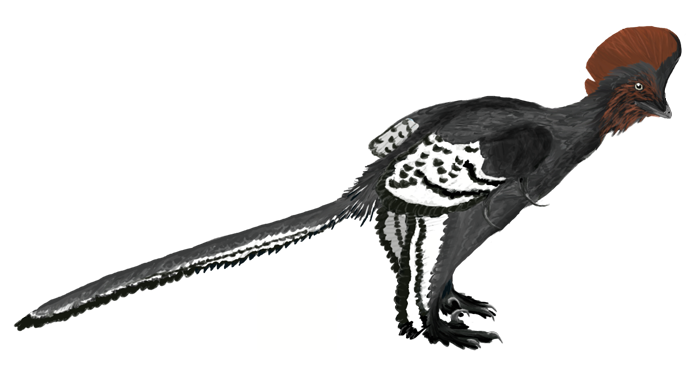Molecular Analysis of Anchiornis Feather Gives Clues to Origin of Flight

An international team of researchers has performed molecular analysis on fossil feathers from a small, feathered dinosaur from the Jurassic. Their research could aid scientists in pinpointing when feathers evolved the capacity for flight during the dinosaur-bird transition.
Anchiornis was a small, feathered, four-winged dinosaur that lived in what is now China around 160 million years ago – almost 10 million years before Archaeopteryx, the first recognized bird. A team of researchers from the Nanjing Institute of Geology and Paleontology, North Carolina State University, and the University of South Carolina analyzed Anchiornis feathers to see how they differed at the molecular level from those of younger fossil birds and modern birds.
“Modern bird feathers are composed primarily of beta-keratin (β-keratin), a protein also found in skin, claws, and beaks of reptiles and birds. Feathers differ from these other β-keratin containing tissues, because the feather protein is modified in a way that makes them more flexible,” says Mary Schweitzer, professor of biological sciences at NC State with a joint appointment at the North Carolina Museum of Natural Sciences and co-author of a paper describing the research.
“At some point during the evolution of feathers, one of the β-keratin genes underwent a deletion event, making the resultant protein slightly smaller. This deletion changed the biophysics of the feather to something more flexible – a requirement for flight. If we can pinpoint when, and in what organisms, that deletion event occurred, we will have a better grasp on when flight evolved during the transition from dinosaurs to birds.”
The researchers, led by Yanhong Pan, a visiting researcher from the Nanjing Institute, examined fossilized feathers from Anchiornis, using high-resolution electron microscopy, as well as multiple chemical and immunological techniques to determine the molecular composition of the feathers. They did the same to other feathers from the Mesozoic and Cenozoic eras, as well as other β-keratin tissues not expected to show this deletion, then compared results with modern bird feathers and tissues.
They found that Anchiornis feathers were comprised of both β-keratins and alpha-keratins (α-keratins), a protein all terrestrial vertebrates have, including mammals. This was surprising because α-keratin is present in only small amounts in modern feathers. In addition to co-expressing both keratin proteins, the Anchiornis feathers had already undergone the deletion event that sets feathers apart from other tissues.
“Molecular clocks, which scientists use as benchmarks for evolutionary and genetic divergence, predict that the deletion, and thus functional flight feathers, evolved around 145 million years ago,” Schweitzer says. “Anchiornis is millions of years older, yet has the shortened protein form. This work shows that we can utilize molecular fossil data to root molecular clocks and improve their accuracy – we can start to put timing on genetic events in the dinosaur-bird transition via absence or presence of these two keratins. The data also give us more information about how feathers evolved to enable flight.”
The work appears in Proceedings of the National Academy of Sciences. Pan is lead author. Wenxia Zheng and Elena Schroeter of NC State and Roger Sawyer from the University of South Carolina also contributed to the work, which was supported in part by the National Science Foundation and the Packard Foundation.
-peake-
Note to editors: An abstract follows.
“The molecular evolution of feathers: Direct evidence from fossils”
Authors: Yanhong Pan, Nanking Institute of Geology and Paleontology; Roger Sawyer, University of South Carolina; Wenxia Zheng, Elena Schroeter, Mary Schweitzer, North Carolina State University; et al
Published: Proceedings of the National Academy of Sciences
Abstract:
Dinosaur fossils possessing integumentary appendages of various morphologies, interpreted as feathers, have greatly enhanced our understanding of the evolutionary link between birds and dinosaurs, as well as the origins of feathers and avian flight. In extant birds, the unique expression and amino acid composition of proteins in mature feathers have been shown to determine their biomechanical properties, such as hardness, resilience, and plasticity. Here, we provide molecular and ultrastructural evidence that the pennaceous feathers of the Jurassic non-avian dinosaur Anchiornis were comprised of both feather β-keratins and αkeratins. This is significant because mature feathers in extant birds are dominated by β-keratins, particularly in the barbs and barbules forming the vane. We confirm herein that feathers were modified at both molecular and morphological levels to obtain the biomechanical properties for flight during the dinosaur-bird transition, and we show that the patterns and timing of adaptive change at the molecular level can be directly addressed in exceptionally preserved fossils in deep time.
- Categories:


